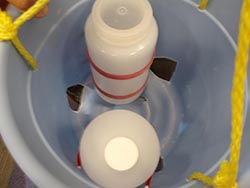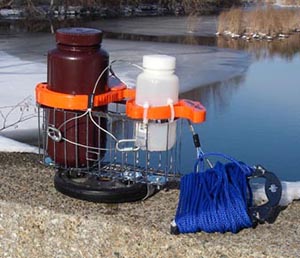Question
On Jan 17, 2005, at 12:30 AM, Eleanor Ely wrote:
Dear friends:
Today I got a call from a writer who wanted quick and easy answers to large and difficult questions about volunteer monitoring. I was little annoyed that he seemed to be trying to throw something together at the last minute with a minimum of effort. But at the same time I felt bad that I couldn’t answer his questions. He was mainly looking for “news” — specifically, he wanted to know what’s new in the past decade. Is volunteer monitoring “growing”? Are there more programs, or more volunteers? What are the latest trends? (More centralization? More collaboration?) What new volunteer monitoring equipment or methods have been developed in the past decade? I wasn’t very helpful, and I tried to explain that no one really knows the answers to some of these questions — that it would take a lot of research and time to find out. But after I got off the phone two ideas occurred to me.
The first was that in some ways he was asking the wrong questions. He was looking for what’s new, what’s different. And I started thinking that a lot of the value of monitoring comes from what is NOT new. The fact that a lot of groups celebrated their 10th, 20th, or even 30th anniversary last year is probably more important than how many new groups formed that year or what new technologies were developed. The fact that some volunteers celebrated their 5th, 10th, or 15th anniversary with a monitoring program is probably more important than how many new volunteers the program recruited. In a sense, what you want to see in a volunteer monitoring program is the “same old same old” — same volunteers, same methods and parameters, and even (if your water body is healthy) the same results. And yet, as has been noted before, that sort of thing is not glamorous and sexy; it’s not “news.” Which is one of the things that makes it hard to convince policymakers and funders of the value of long-term monitoring.
But after thinking all that, I also decided that there probably IS some “news,” and that was when I got my second idea — the idea of asking people on this listserv for their views. I would love to hear your comments on my preliminary thoughts (see below) about possible “trends” in the last decade.
– Are there more programs? Since there hasn’t been a survey since 1998, I don’t think anyone knows the answer. My impression is that budget cuts have taken their toll on volunteer monitoring and that some groups have gone under. At the same time, though, new groups have also formed. But I don’t have a clear sense that there has been net growth. What do others think? – Speaking of budget cuts, for the last 15 years I’ve been hearing about the “slashing” of agency and volunteer funding, but my gut feeling is that it’s more serious now. I think volunteer groups are responding in various ways — looking for new sources of support, and at the same time tightening belts more than before. And while the “positive spin” might be that volunteer groups are finding new partners and that agencies are more open to volunteer data (since they can’t afford to collect their own), my sense is that on the whole volunteer monitoring is suffering from a decline in funding — that programs are having to cut back their activities, reduce the number of volunteers, and in some cases close down operations altogether. I’m hoping that some of you can convince me that this view is overly bleak. – Is there more centralization and/or collaboration? I know that monitoring programs are always forming new partnerships, trying to coordinate with other groups in the watershed, etc. Is there more of that now than 10 years ago? I’m not sure. However, I think I would feel pretty safe in saying that there is more data sharing, partly because nowadays groups are posting their data on the Internet, which wasn’t happening 10 years ago.
– Are volunteer monitoring data being more accepted by agencies, researchers, etc.? Certainly we would all like to think so! Based on ”anecdotal evidence,” I would answer this question in the affirmative. But maybe that’s because I tend to hear the good news — people are more interested in telling the world about their success than about their frustration. What do others think — is there a genuine trend toward more acceptance of volunteer monitoring data?
– New developments in methodology and equipment? The writer who called me had glanced at the most recent VM and noticed the picture of the horizontal clarity tube, so he suggested that “horizontal monitoring” might be a hot new trend. No, I said (mentally picturing monitors lying down next to their water bodies), I didn’t think horizontal monitoring would be a good example of a new trend, but perhaps the clarity tube itself (vertical version) might qualify as an important new piece of equipment introduced in the past decade. Now I’m trying to think of other examples. What about the relatively new simplified methods for monitoring coliforms and E. coli, which are gaining more and more widespread use? Any other ideas?
– Another new trend, I think, is online data entry. Would anyone like to comment on the significance of this?
Thanks, everyone, for your patience in reading all this. I’m looking forward to receiving some interesting feedback, and perhaps publishing a summary of responses in the next issue of the newsletter. I think in this case it might be useful to post responses to the entire listserv. Maybe we can get a dialog going.
Ellie
Eleanor Ely
Editor, The Volunteer Monitor Newsletter
50 Benton Avenue
San Francisco, CA 94112
Responses
Date: Mon, 17 Jan 2005 07:17:14 -0800 (PST)
From: David J Wilson
Subject: Re: [volmonitor] ideas needed — volunteer monitoring “trends”
Dear Ellie,
(1) I agree with you that it is rather stupid for someone to attempt to throw together on short notice a picture of the current state of affairs in volunteer monitoring. Such an article is likely to be loaded with errors and may do more harm than good. Sorry.
(2) Given that sediment is a major water quality problem nationally, the appearance on the scene of cheap turbidity/transparency tubes is certainly significant. This is strongly reinforced by Tim Diehl’s (USGS, Nashville office) work showing the excellent correlation between transparencies and nephelometric turbidimeter measurements. The cost of a turbidity tube is sufficiently small that a volunteer group can pay for a few of these out of its own pockets, as was done by the Harpeth River Watershed Association in TN and as we are doing in the Huron River Watershed Council in MI. The horizontal tube is an interesting extension of the turbidity tube technique; we have not, however, needed it in any of our turbidity/TSS work on the Harpeth and the Huron Rivers, and I do not expect that it will be a major player.
(3) Most states are having extreme budgetary difficulties; the enormous federal government is piling up staggering budget deficits; and the present federal administration has shown itself to be extremely hostile to any and all environmental concerns. I therefore think that we shall see volunteer monitoring groups focussing on getting the most bang for their own bucks, rather than wasting time hustling for non-existent state and federal dollars. Sediment studies, studies that can be done with field test kits (DO, phosphate, nitrate, pH), visual assessments, bank erosion monitoring, and benthic macroinvertebrate studies are all examples of monitoring that can be done on a low budget–at a price a volunteer group can raise on its own without government assistance. I note that this was the way volunteer monitoring started out before it even had a name; concerned and outraged citizens’ groups raised their own money and did! their own thing with the governments dragging their feet at every level. See, for example, what was done by volunteer groups in Rochester, NY, and St. Louis back in the 60’s. Yes, it is nice to be able to get government money. It is very nice to be able to have the support and guidance of paid professional staff. But this is not necessary in order for us to do what needs to be done, as was established back in the 60’s.
(4) THE crucial, essential element in effective volunteer monitoring is not government money, but the presence of a small cadre, either professional staff or volunteer people, who are dedicated and who are knowledgeable about the techniques and procedures to be used and can train the other volunteers. If we cannot hire professional staff for this, then it will be necessary for people with professional training in chemistry, biology, etc., to come forward to do it, as we did back in the 60’s and 70’s. See, for example, Proc. Rochester Acad. Sci., Oct. 1982 special edition, Studies of Pollution Control in a Lakefront Community 1964-1981. Government money certainly makes things easier and faster by allowing the use of full-time professional staff (bless them!) and the running of high-ticket projects. But government money is not essential. Dedicated, concerned, angry people are essential.
With best regards,
Dave Wilson
Date: Tue, 18 Jan 2005 08:53:24 -0500
From: Nancy Hadley
Subject: Re: [volmonitor] ideas needed — volunteer monitoring “trends”
To: Volunteer water monitoring
I think online data entry is one of the biggest advances. It not only gets the data into your database faster (although perhaps complicating the QA/QC) but it gives the volunteers an additional sense of responsibility and ownership. That is what keeps volunteers in the program. If you just monitor and the data goes away, you are disconnected. the connection is key.
As to new equipment, we are using a dissolved oxygen kit by Chemets which I think is awesome. However, I dont have the sense anybody else is using it. I know it is not yet EPA approved so tht may be why. I would be interested in hearing from anybody who has tried this kit and what they thought.
Nancy Hadley
hadleyn@mrd.dnr.state.sc.us
South Carolina Oyster Restoration and Enhancement Program
Marine Resources Research Institute
South Carolina Department of Natural Resources
PO Box 12559
217 Fort Johnson Road
Charleston, SC 29412
(843) 953-9841
(843) 953-9820 (fax)
http://www3.csc.noaa.gov/scoysters


